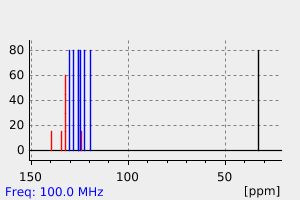2-甲基二苯并[c,e][1,2]噻嗪1,1-二氧化物 | 40182-28-3
中文名称
2-甲基二苯并[c,e][1,2]噻嗪1,1-二氧化物
中文别名
——
英文名称
6-methyl-6H-dibenzo[c,e][1,2]thiazine 5,5-dioxide
英文别名
6-methylbenzo[c][1,2]benzothiazine 5,5-dioxide
CAS
40182-28-3
化学式
C13H11NO2S
mdl
——
分子量
245.302
InChiKey
SNZIZHFNRMQFOQ-UHFFFAOYSA-N
BEILSTEIN
——
EINECS
——
-
物化性质
-
计算性质
-
ADMET
-
安全信息
-
SDS
-
制备方法与用途
-
上下游信息
-
文献信息
-
表征谱图
-
同类化合物
-
相关功能分类
-
相关结构分类
物化性质
-
沸点:449.6±28.0 °C(Predicted)
-
密度:1.335±0.06 g/cm3(Predicted)
计算性质
-
辛醇/水分配系数(LogP):2.3
-
重原子数:17
-
可旋转键数:0
-
环数:3.0
-
sp3杂化的碳原子比例:0.08
-
拓扑面积:45.8
-
氢给体数:0
-
氢受体数:3
上下游信息
-
上游原料
中文名称 英文名称 CAS号 化学式 分子量 —— 6H-dibenzo[c,e][1,2]thiazine 5,5-dioxide 1864-33-1 C12H9NO2S 231.275
反应信息
-
作为反应物:描述:2-甲基二苯并[c,e][1,2]噻嗪1,1-二氧化物 在 碘苯二乙酸 、 sodium bromide 作用下, 以 水 为溶剂, 以96%的产率得到9-bromo-6-methyl-6H-dibenzo[c,e][1,2]thiazine 5,5-dioxide参考文献:名称:Facial Syntheses of Bromobenzothiazines via Catalyst-Free Tandem C–H Amination/Bromination in Water摘要:A transition-metal-free and environmentally friendly synthesis method for bromobenzothiazines through tandem C-H amination/bromination was reported. This reaction contains both intramolecular C-H amination and site-selective electrophilic bromination of arenes with NaBr as the bromo source, PhI(OAc)(2) or K2S2O8 as the oxidant, and H2O as the only solvent.DOI:10.1021/acs.orglett.9b02131
-
作为产物:描述:邻氯苯磺酰胺 在 copper(l) iodide 、 potassium tert-butylate 、 potassium carbonate 、 N,N'-二甲基乙二胺 作用下, 以 二甲基亚砜 、 乙腈 为溶剂, 反应 26.0h, 生成 2-甲基二苯并[c,e][1,2]噻嗪1,1-二氧化物参考文献:名称:具有抗增殖活性的微管蛋白靶向二苯并噻嗪作为新型杂环结构单元的设计、合成和体外评价摘要:我们从N-芳基苯磺酰胺中制备了一系列具有潜在抗肿瘤活性的游离 NH 和N-取代的二苯并噻嗪。在体外对合成的化合物(59 个样品)进行了生物学测试,测量了它们对一组六种人类实体肿瘤细胞系的抗增殖活性及其微管蛋白抑制活性。我们鉴定了 6-(苯磺酰基)-6 H-二苯并[ c , e ][1,2]噻嗪 5,5-二氧化物和 6-甲苯磺酰基-6 H-二苯并 [ c , e][1,2]噻嗪 5,5-二氧化物是具有良好活性值的最佳化合物(总体范围为 2–5.4 μM)。在此,我们报告了二苯并噻嗪核心作为具有抗增殖活性的新型构件,针对微管蛋白动力学。DOI:10.1002/cmdc.202100383
文献信息
-
Investigation of the Mechanism of C(sp<sup>3</sup>)−H Bond Cleavage in Pd(0)-Catalyzed Intramolecular Alkane Arylation Adjacent to Amides and Sulfonamides作者:Sophie Rousseaux、Serge I. Gorelsky、Benjamin K. W. Chung、Keith FagnouDOI:10.1021/ja103081n日期:2010.8.11reactivity of C(sp(3))-H bonds adjacent to a nitrogen atom can be tuned to allow intramolecular alkane arylation under Pd(0) catalysis. Diminishing the Lewis basicity of the nitrogen lone pair is crucial for this catalytic activity. A range of N-methylamides and sulfonamides react exclusively at primary C(sp(3))-H bonds to afford the products of alkane arylation in good yields. The isolation of a Pd(II) reaction可以调整与氮原子相邻的 C(sp(3))-H 键的反应性,以允许在 Pd(0) 催化下进行分子内烷烃芳基化。降低氮孤对的路易斯碱度对于这种催化活性至关重要。一系列 N-甲基酰胺和磺酰胺仅在初级 C(sp(3))-H 键上反应,以高产率提供烷烃芳基化产物。Pd(II) 反应中间体的分离使得能够评估反应机理,重点是碱在 C(sp(3))-H 键断裂步骤中的作用。这些化学计量研究的结果,连同动力学同位素效应实验,为协调的金属化-去质子化 (CMD) 过渡态提供了罕见的实验支持,此前已在烷烃 C(sp(3))-H 芳基化中提出了这种过渡态。而且,DFT 计算揭示了新戊酸盐添加剂作为磷化氢从 Pd(II) 中间体解离的促进剂的额外作用,使 CMD 过渡态成为可能。最后,进行了动力学研究,揭示了反应速率表达及其与新戊酸盐浓度的关系。
-
Structurally Diverse Synthesis of Five-, Six-, and Seven-Membered Benzosultams through Electrochemical Cyclization作者:Aiyun Liu、Tiantian Guo、Shuangshuang Zhang、Han Yang、Qi Zhang、Yonghai Chai、Shengyong ZhangDOI:10.1021/acs.orglett.1c02128日期:2021.8.20to structurally diverse synthesis of benzosultams from aryl sulfonamides through an electrochemical cyclization. Upon variation of the ortho substituent on aryl sulfonamides, five-, six-, and seven-membered benzosultams were efficiently assembled in an atom- and resource-economic manner. The generality of the process is demonstrated by the formation of five- to seven-membered cyclic products from 42
-
Syntheses of Bromo-<i>N</i>-heterocycles through Dibromohydantoin-Promoted Tandem C–H Amination/Bromination作者:Yan-Na Ma、Yan Gao、Yi Jing、Jiaxin Kang、Jie Zhang、Xuenian ChenDOI:10.1021/acs.joc.9b01833日期:2020.3.6Herein, we report a metal-free radical tandem C–H amination and bromination reaction with dibromohydantoin (DBH) as both the amination and bromination reagents and water as the main solvent. The reaction involves in intramolecular C–H amination and electrophilic bromination using cheap commercially available DBH. The products represent heterocyclic building blocks, readily modifiable by classical cross-coupling
-
Aryl radical-induced desulfonylative<i>ipso</i>-substitution of diaryliodonium salts: an efficient route to sterically hindered biarylamines作者:Huangguan Chen、Limin Wang、Jianwei HanDOI:10.1039/d0cc01766c日期:——By using vicinal aryl sulfonamide substituted diaryliodonium salts, a cascade of desulfonylation/aryl migration was promoted by triethylamine in the synthesis of sterically hindered biarylamines, which operated via a radical-induced reaction pathway. The products were readily converted into a variety of important synthons. Furthermore, coupling reactions of N-methyl biarylamine and 1,6-dibromopyrene
-
A Further Decrease in the Catalyst Loading for the Palladium-Catalyzed Direct Intramolecular Arylation of Amides and Sulfonamides作者:Nerea Conde、Fátima Churruca、Raul SanMartin、María Teresa Herrero、Esther DomínguezDOI:10.1002/adsc.201401129日期:2015.5.4The direct arylation of N‐substituted o‐bromobenzanilides and benzenesulfonamides via CH bond functionalization has been developed using very low catalyst loadings. This novel cost‐effective and more sustainable method relies on a PCN‐type palladium pincer complex as a highly active palladium source, providing a general and efficient access to phenanthridinones, biaryl sultams and related heterocyclic
表征谱图
-
氢谱1HNMR
-
质谱MS
-
碳谱13CNMR
-
红外IR
-
拉曼Raman
-
峰位数据
-
峰位匹配
-
表征信息
同类化合物
高氟奋乃静
马来酸甲哌丙嗪
马来酸奋乃静
马来酸乙巯拉嗪
锁匹达新
醋酸奋乃静
醋异丙嗪
酒石酸异丁嗪
还原亚甲蓝
达赛马嗪
螺氯丙嗪
莫雷西嗪亚砜
茶氯酸异丙嗪
苹果酸硫乙拉嗪
苯达莫司汀杂质A
苯甲酸2-(2H-1,4-苯并噻嗪-3-基)酰肼
苯甲酸,4-硝基-2-[[3-(三氟甲基)苯基]氨基]-
苯甲酰基氧基甲基-[3-(2-氯吩噻嗪-10-基)丙基]-二甲基氯化铵
苯并噻嗪-5-氧化
苯并噻嗪-5-正离子,3,7-二(二甲氨基)-4-碘-,氯化
苯并噻嗪,10-(2-(4-丙基-1-哌嗪基)丙基)-
苯并[b]吩噻嗪-12-基(苯基)甲酮
苯并[a]吩噻嗪-5-酮
苯丙嗪
苄酰基无色亚甲基兰
芬诺宁
芬乙嗪
舒多昔康
羟乙哌氟嗪
美索哒嗪
美索丙嗪
美洛昔康钾盐
美洛昔康钠
美洛昔康-d3
美洛昔康
美托奋乃酯
美托哌丙嗪酸
美托哌丙嗪
美托咪嗪-d6
美喹他嗪亚砜
美喹他嗪
磺达嗪
硫堇(劳氏紫)
硫利达嗪杂质A(EP)
硫利达嗪N-氧化物
硫利达嗪-5-亚砜
硫利达嗪
硫代哒嗪-d35-亚砜
硫丙拉嗪
盐酸诺美丙嗪







